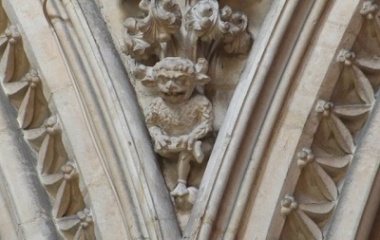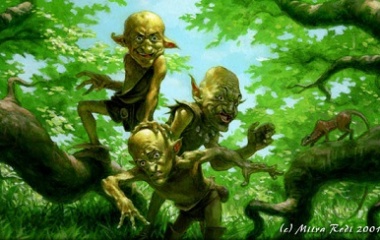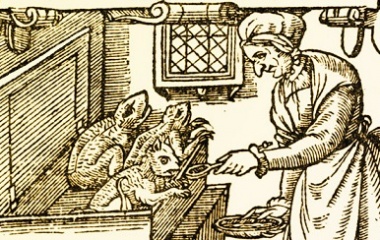If you haven’t already been waylaid by fairies, pixies, or goblins on your trip through Europe’s lovely countryside, you will almost certainly be targeted by Imps. These feisty little creatures love nothing more than to irk humans. You should just hope that the Imp who targets you is acting of his own accord. If his master has set him on you, you have much bigger problems than fending off the little rascal!
What Are Imps?
Imps are minor magical creatures with a big appetite for the spotlight. Always desirous of attention, they act out through practical jokes and small outbursts of magic, trying to get anyone to pay attention to them. Unfortunately, they are so small and unimportant that they don’t succeed at getting much attention—except, perhaps, from crafty evildoers who are willing to take them on as slaves.
Characteristics
Physical Description
The Imp’s appearance certainly doesn’t help him ingratiate himself with others. By all accounts, Imps are small, bony, unattractive creatures. Their faces are like masks of thin stone, which are frequently twisted into a smirk or a grimace. Oversized ears and horns sprout from their heads, just as leathery, bat-like wings sprout from their shoulders. Their skin, ranging in color from purple to red-brown to gray, may be scaly or stone-like, and they walk with an unpleasant hunch.
Some of these unpleasant creatures more closely resemble monkeys or cats than humans. Their noses are elongated into snouts, and they prefer to move on four paw-like hands rather than walking on their hind legs.
Occasionally, an Imp might be magically bound to an object, like a bottle, a crystal ball, or a staff. They may take a corporeal form when summoned from this object, or they may lose their corporeal form altogether and exist only as a spirit in the object.
Special Abilities
Imps are talented pranksters. Switching babies in a cradle or leading someone astray in the wilderness is child’s play for them. Still, they don’t design elaborate, malicious schemes by themselves. Their pranks are nothing more than the impulse of a moment, and if an Imp is found engaged in a more nefarious plan, someone else is probably the mastermind.
Some folktales credit Imps with magical power, but all of them acknowledge that these little creatures are minor in comparison to other magical beings. The Imp does have a knack for shapeshifting, and many are good at conjuring up fire as well. They make excellent spies, as they can sneak along quietly and disguise themselves or disappear when necessary.
Related Creatures
Despite its obnoxious behavior, the Imp delights in the company of its fellow creatures. In fact, most of their outbursts are only intended to win the attention of onlookers or gain the approval of an unseen master.
In early mythological accounts, Imps relied on each other, and the occasional human passerby, for amusement. Over time, they began to be connected with darker forces, often being depicted as toadies for witches and warlocks, or worse, demons in league with the devil.
In its appearance and behavior, the Imp is closely related to the goblins, elves, and fairies of English and Germanic folklore. The Imp is distinguished from these creatures by its relatively low place on the magical totem pole and by its desire for human companionship.
History
Origin
Imps sprung from Germanic folklore, where they were typically described as “lesser goblins.” When they worked their way into English folklore, they were given their current name, which was based on the old English word ympa, meaning “offshoot of a tree.” This name was chosen because they were viewed as lesser beings, usually controlled by mightier (and darker) forces.
Rise with Sorcery
During the Christianization of Western Europe, Imps were transformed from attention-seeking pranksters into satanic minions. The Imp’s reputation festered under the shadow of this new allegiance, but it didn’t rupture into violence until the witch-hunt craze of the Renaissance.
Because sorcery was seen as a satanic practice, Imps were lumped into the hunt with witches and warlocks. They were believed to take the shape of black cats, rats, or toads when in the service of a witch or warlock, and many innocent men and women were put to trial because they were seen in the presence of “an imp.” After the witch-hunt craze settled down, “imp” reports dwindled as well.
Imps in Art and Literature
Imps have infiltrated architecture more than any of the other arts. The tiny, gargoyle-like creatures peep from the buttresses of giant cathedrals, leer down from the stonework over grand entryways, and crowd around tombs, where they are fended off by angels.
They have also left their fingerprints on literature, mainly appearing in descriptions of Hell. However, some lighter stories have also given the Imp the spotlight it craves. They pop up in some of the famous Grimm brother fairy tales. In 1981, the internationally acclaimed storyteller Robert Louis Stevenson published a tale called “The Bottle Imp,” which featured a crafty, entertaining, and magical spirit trapped in a bottle, and in the 2000s, Jonathan Stroud included Imps in a series of novels about the reluctant servitude, and frequent hijinks, of magical beings enslaved to humans.











How can I register on your website to receive updates and newsletter and be part of your community?